Key Takeaways
- Discover the most reliable corporate tax software in 2025, designed to streamline compliance, automate filings, and reduce manual errors.
- Learn how advanced features like AI-driven calculations, real-time updates, and cloud integration can enhance tax efficiency.
- Find the best tools suited for businesses of all sizes to optimize tax planning and improve financial accuracy.
In today’s fast-evolving business environment, the management of corporate taxes has become more complex, dynamic, and highly regulated than ever before. With governments across the globe tightening compliance requirements, implementing new tax reforms, and adopting advanced digital reporting systems, companies can no longer rely solely on traditional, manual methods to manage their tax obligations. This growing complexity has made the adoption of corporate tax software not just a strategic advantage, but an operational necessity for organizations of all sizes. As we enter 2025, the market for tax technology continues to expand rapidly, offering businesses a diverse range of innovative solutions designed to simplify compliance, optimize tax processes, and reduce the risk of costly errors.
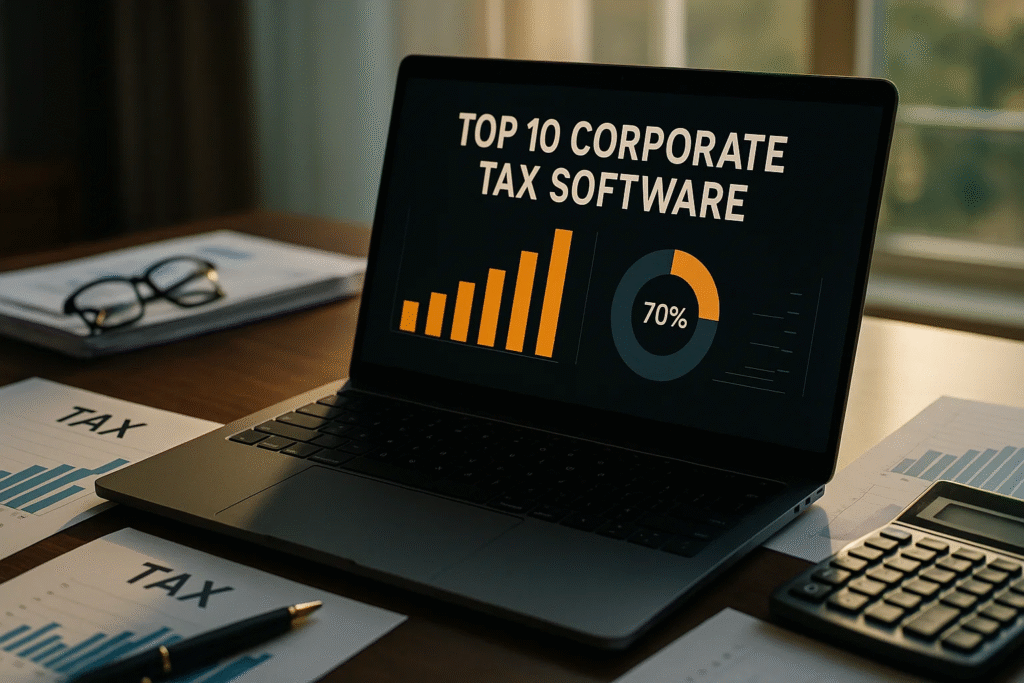
Corporate tax software has emerged as a transformative tool for finance teams, tax professionals, and business leaders who aim to navigate intricate tax regulations efficiently while maximizing operational productivity. These platforms are designed to automate critical processes such as tax calculations, filing, compliance tracking, reporting, and audit preparation. By integrating real-time data analytics, AI-powered recommendations, and cloud-based accessibility, modern tax solutions are no longer just about filing returns—they provide comprehensive tax lifecycle management that supports strategic decision-making. For multinational corporations in particular, the ability to manage varying tax jurisdictions, currency conversions, and cross-border compliance in a centralized system offers an unparalleled advantage in ensuring both accuracy and speed.
The year 2025 marks a pivotal shift in how businesses choose and implement their tax technology. Advanced corporate tax software now goes beyond basic automation, offering integrated features such as predictive tax forecasting, blockchain-based data security, and API connections with accounting, ERP, and financial planning tools. These innovations are driven by the growing demand for transparency, efficiency, and cost control in corporate finance. Furthermore, with regulatory bodies increasingly embracing digital transformation, many tax authorities now require electronic submissions and real-time reporting—making sophisticated tax software indispensable for staying compliant and competitive.
For decision-makers seeking the most effective tools, the challenge lies in identifying the software that aligns with their specific operational needs, industry regulations, and long-term growth strategies. The market offers a wide range of options, from enterprise-level platforms tailored for multinational corporations to scalable cloud solutions ideal for SMEs looking to streamline their tax functions without heavy infrastructure investments. The right software can save countless hours of manual work, reduce the likelihood of human error, and provide actionable insights that support both compliance and financial optimization.
This guide to the top 10 corporate tax software solutions to try in 2025 is designed to help businesses make informed choices in a highly competitive technology landscape. It evaluates platforms based on their functionality, ease of use, scalability, security, and adaptability to evolving regulations. Whether a company’s priority is to ensure flawless compliance, improve internal workflows, or gain deeper visibility into tax data, these solutions represent the forefront of innovation in corporate tax management. By adopting the right technology now, organizations can position themselves to operate more efficiently, minimize compliance risks, and stay ahead in an increasingly digitized financial ecosystem.
Before we venture further into this article, we would like to share who we are and what we do.
About 9cv9
9cv9 is a business tech startup based in Singapore and Asia, with a strong presence all over the world.
With over nine years of startup and business experience, and being highly involved in connecting with thousands of companies and startups, the 9cv9 team has listed some important learning points in this overview of The Top 10 Corporate Tax Software To Try In 2025.
If your company needs recruitment and headhunting services to hire top-quality employees, you can use 9cv9 headhunting and recruitment services to hire top talents and candidates. Find out more here, or send over an email to [email protected].
Or just post 1 free job posting here at 9cv9 Hiring Portal in under 10 minutes.
Top 10 Corporate Tax Software To Try In 2025
- Thomson Reuters (ONESOURCE & UltraTax CS)
- Avalara
- Vertex
- Wolters Kluwer (CCH Axcess Tax & CCH Integrator)
- CSC Corptax
- Sovos
- SAP Tax Management Module
- Oracle Tax Reporting Cloud
- Intuit Lacerte Tax
- Intuit ProConnect Tax
1. Thomson Reuters (ONESOURCE & UltraTax CS)
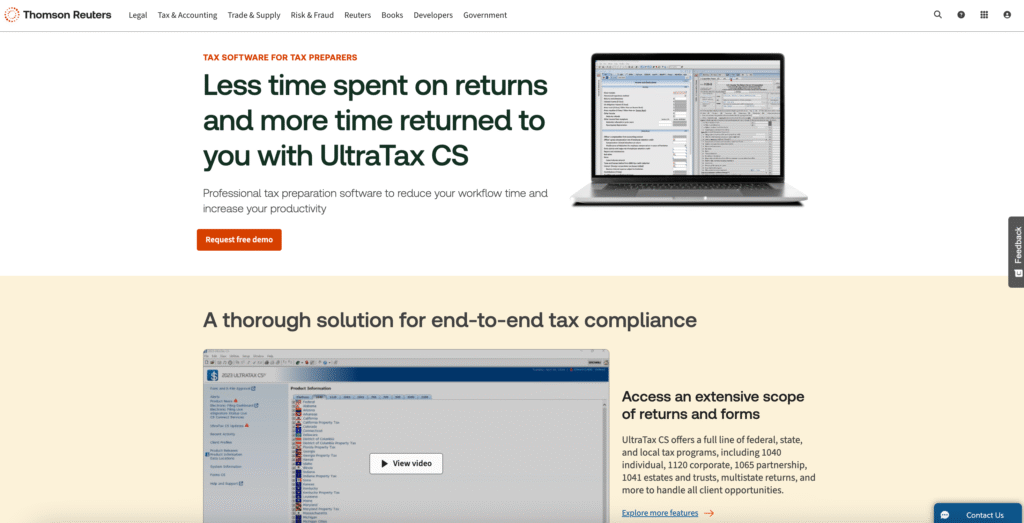
Thomson Reuters remains a formidable leader in the corporate and professional tax software arena, offering two flagship solutions tailored to distinct market segments. Its ONESOURCE platform addresses the complex compliance demands of multinational enterprises, while UltraTax CS caters to the precise needs of professional accounting firms. This dual-solution approach positions Thomson Reuters as a trusted partner for organizations seeking cutting-edge tax compliance technology in 2025.
ONESOURCE – The Enterprise Powerhouse for Global Tax Management
- Comprehensive End-to-End Suite
- Covers the complete lifecycle of tax, trade, and financial reporting across 45+ jurisdictions.
- Integrates direct tax, indirect tax, global trade management, and statutory reporting into a unified platform.
- AI-Driven Efficiency
- Incorporates AI-native modules like Ready to Advise and Ready to Review to enhance compliance accuracy and decision-making speed.
- Automates routine tax workflows, reducing manual intervention and minimizing compliance risks.
- Seamless ERP Integration
- Fully cloud-based with multiple SAP-certified integrations, enabling a “clean-core” compliance pathway without disrupting ERP functionality.
- Compatible with diverse enterprise resource planning systems, ensuring smooth adoption for large-scale operations.
- Proven Business Impact
- Reported efficiency improvements:
- 50% in indirect tax compliance processing times
- 68% in statutory reporting turnaround
- Over USD 1 billion in annual savings from foreign-trade zone optimization
- Reported efficiency improvements:
- Flexible Pricing Models
- Customized enterprise pricing tailored to operational scope and geographic reach.
- Publicly listed ONESOURCE Fast Sales Tax Rate File pricing:
- Complete Plan: USD 10,000 (12-month subscription)
- Premium Plan: USD 20,000 (12-month subscription)
UltraTax CS – The Preferred Choice for Professional Accounting Firms
- Market Leadership
- Utilized by 22.6% of Certified Public Accountants (CPAs) in the 2024 industry survey, marking it as one of the most trusted tax preparation tools.
- Precision-First Design
- Offers robust compliance features for income tax preparation, e-filing, and advanced reporting for diverse client portfolios.
- Built with an intuitive user interface tailored for high-volume tax preparation environments.
- Time-Saving Capabilities
- Automates data imports, batch processing, and form completion to expedite filing during peak seasons.
Feature & Benefit Comparison Matrix
| Feature / Benefit | ONESOURCE (Enterprise) | UltraTax CS (Professional Firms) |
|---|---|---|
| Target Market | Multinational corporations | CPA firms and small-to-mid accounting practices |
| Coverage | Global (45+ countries) | Primarily US federal & state tax compliance |
| AI Integration | Yes – AI-native apps for review & advisory tasks | Limited AI automation for workflow optimization |
| ERP Integration | Multi-ERP support, SAP-certified | Not ERP-focused |
| Efficiency Gains | 50%+ in tax compliance, 68% in reporting | Significant reduction in preparation times |
| Annual Cost Range | USD 10,000 – 20,000+ (custom quotes available) | Subscription-based, varies by modules & licenses |
| Distinct Competitive Advantage | Global compliance with trade optimization savings | High adoption rate among US CPAs |
Why Thomson Reuters Earns a Spot Among the Top Corporate Tax Software in 2025
- Versatility Across Market Segments – Whether a multinational enterprise or a boutique CPA firm, Thomson Reuters delivers specialized solutions that address unique tax compliance needs.
- Proven ROI and Operational Savings – The ability to reduce compliance time by half and generate billion-dollar savings in trade duties underscores its tangible business value.
- Future-Ready with AI Innovation – Embedding AI tools for smarter advisory and review processes positions the platform as a forward-looking investment.
- Unmatched Global Reach – From handling complex indirect taxes in multiple jurisdictions to meeting statutory obligations across continents, ONESOURCE remains unmatched in scope.
2. Avalara

Avalara stands as a leading authority in tax automation technology, recognized for streamlining sales, use, VAT, and GST compliance for organizations ranging from agile e-commerce startups to multinational corporations. With its flagship product, AvaTax, Avalara has redefined how businesses approach indirect tax calculations by delivering real-time accuracy across thousands of tax jurisdictions worldwide.
AvaTax – Precision in Real-Time Tax Calculation
- Comprehensive Tax Coverage
- Dynamically calculates sales and use tax in real time based on the customer’s precise geo-location.
- Covers more than 12,000 taxing jurisdictions in the United States, while also supporting international VAT and GST obligations.
- Seamless Integration Ecosystem
- Features over 1,400 signed partner integrations with top ERP, e-commerce, POS, and financial systems.
- Enables businesses to embed automated tax calculation directly into existing operational workflows without major infrastructure overhauls.
- Advanced Automation for Compliance Accuracy
- Automatically updates tax rates and rules to maintain compliance with ever-changing regulations.
- Reduces risks associated with manual errors in tax rate application and jurisdiction mapping.
Efficiency Gains and Measurable ROI
- Proven Financial Impact
- Forrester’s Total Economic Impact study reported:
- A three-year risk-adjusted ROI of 153%
- A net present value (NPV) of USD 465,000 for a composite organization using Avalara solutions
- Delivered operational cost savings that translate directly into bottom-line improvements.
- Forrester’s Total Economic Impact study reported:
- Substantial Time Reductions
- 85% decrease in time spent on audit preparation.
- 85% decrease in time required to manage tax returns.
- 50% decrease in time spent managing exemption certificates.
Flexible Pricing Model for Scalability
- Subscription Plans
- Entry-level pricing starts at USD 19 per month for AvaTax services.
- Returns Service
- Filing costs between USD 42 and USD 54 per return, plus an activation fee ranging from USD 25 to USD 475.
- High transaction volumes can qualify for tiered discounts, making Avalara cost-effective for growing enterprises.
Comparative Benefits Table
| Key Feature / Benefit | Avalara AvaTax | Traditional Manual Tax Compliance |
|---|---|---|
| Real-Time Tax Calculation | Yes – across 12,000+ US jurisdictions and global VAT/GST | No – manual lookups and jurisdiction mapping |
| Integration Capabilities | 1,400+ ERP, e-commerce, POS, and financial integrations | Limited, requiring manual data entry |
| Automation of Rate Updates | Automatic, cloud-based | Manual tracking of tax rate changes |
| Time Savings in Compliance | Up to 85% reduction in preparation and return management | Minimal to no time savings |
| ROI & Financial Impact | 153% three-year ROI, USD 465K NPV | No measurable ROI |
Why Avalara is Among the Top Corporate Tax Software to Try in 2025
- Universal Appeal – Scales effortlessly for both small businesses and global enterprises.
- Regulatory Agility – Keeps pace with rapidly changing tax laws to ensure continuous compliance.
- Proven ROI and Efficiency Gains – Backed by independent research validating significant cost savings and operational improvements.
- Integration Excellence – Connects seamlessly with industry-leading systems, eliminating the need for disruptive system migrations.
3. Vertex
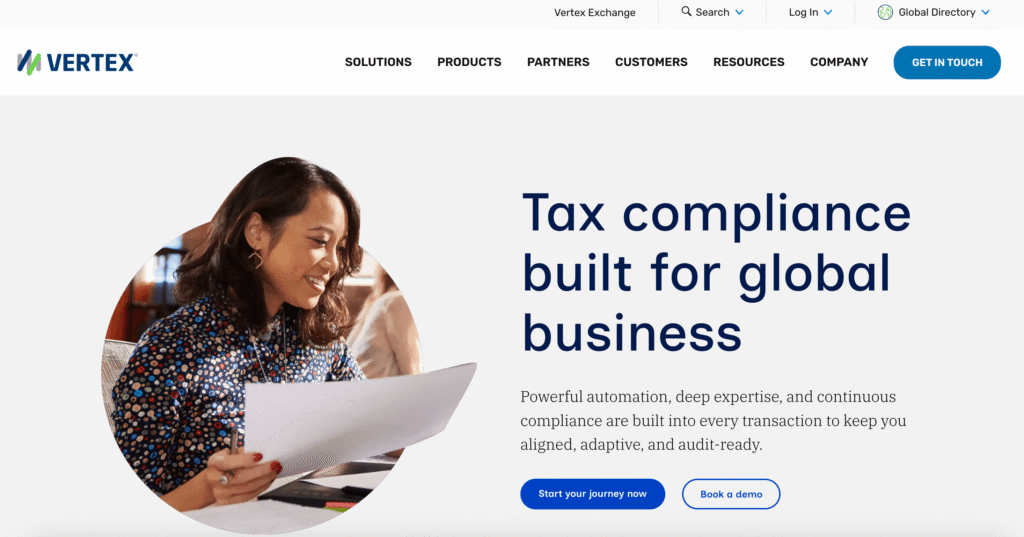
Vertex has established itself as one of the most trusted names in indirect tax automation, serving as a strategic partner for some of the world’s largest corporations. With more than half of Fortune 500 companies relying on its solutions, Vertex stands out as a powerhouse for handling the complexities of global tax compliance, from sales and use tax to VAT and GST.
Enterprise-Grade Indirect Tax Automation
- Comprehensive Indirect Tax Coverage
- Automates sales and use tax, VAT, GST, and other indirect tax obligations for multinational enterprises.
- Offers built-in tools for e-invoicing, exemption certificate management, and compliance reporting.
- Specialized for Large-Scale Operations
- Designed to handle high transaction volumes across multiple business entities and international markets.
- Delivers accurate tax calculations in real time, ensuring compliance with jurisdiction-specific regulations.
Integration and Deployment Flexibility
- Seamless ERP Compatibility
- Natively integrates with leading ERP platforms such as SAP, Oracle, and NetSuite.
- Reduces deployment complexity and ensures smooth interoperability with enterprise systems.
- O Series Platform – Flexible Deployment Options
- Offers on-premise deployment for companies with stringent data residency requirements or highly customized ERP configurations.
- Maintains full control over tax data while benefiting from Vertex’s calculation and compliance capabilities.
Proven Operational Transformation
- Case Study Highlights
- A large-scale client standardized exemption certificate processes across 300 locations.
- This transformation reduced staff required for certificate entry from 200 employees to just 25, significantly lowering administrative costs and improving process efficiency.
- Fortune 500 Adoption Rate
- Over 50% of Fortune 500 companies rely on Vertex, underscoring its credibility and capacity to support mission-critical tax operations.
Pricing Insights
- Custom Quote Model
- Pricing tailored to each enterprise’s scale, industry, and geographic scope.
- Market Data Estimates
- Third-party purchasing data (based on 29 transactions) indicates:
- Median annual cost: USD 32,770
- Range: USD 8,480 to USD 149,342 depending on deployment and service scope
- Third-party purchasing data (based on 29 transactions) indicates:
Comparative Benefits Table
| Key Feature / Benefit | Vertex | Generic Tax Solutions |
|---|---|---|
| Target Market | Large enterprises, Fortune 500 companies | SMEs and general businesses |
| Tax Coverage | Indirect taxes – Sales, Use, VAT, GST | Limited or fragmented coverage |
| ERP Integration | SAP, Oracle, NetSuite, and other enterprise-grade ERPs | Limited ERP compatibility |
| Deployment Options | Cloud & on-premise (O Series) | Mostly cloud-only |
| Data Residency Control | Yes – on-premise option | Rarely available |
| Efficiency Gains | Significant staffing and process optimization | Moderate |
| Pricing Model | Custom quotes, enterprise-focused | Standard SaaS or per-user plans |
Why Vertex is a Top Corporate Tax Software Choice for 2025
- Enterprise-First Engineering – Purpose-built for large-scale, high-complexity tax environments.
- Unmatched Market Trust – Endorsed by more than half of Fortune 500 companies.
- Operational Efficiency at Scale – Delivers measurable cost reductions and process improvements.
- Flexible Deployment for Compliance and Control – Offers both cloud and on-premise solutions to meet diverse corporate IT policies.
4. Wolters Kluwer (CCH Axcess Tax & CCH Integrator)
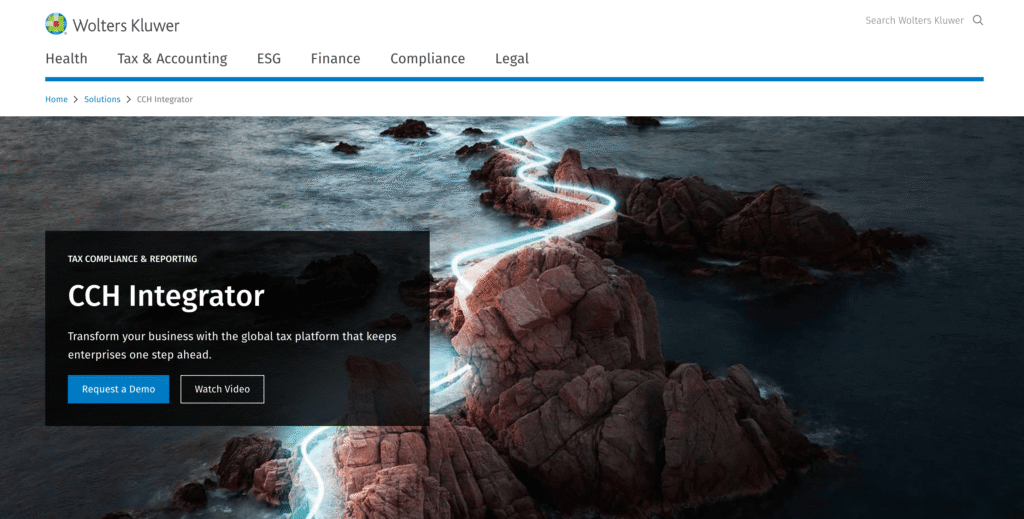
Wolters Kluwer is a longstanding authority in tax, accounting, and compliance technology, delivering a suite of solutions that address both domestic and international tax obligations. Its portfolio is strategically designed to meet the needs of two distinct audiences: professional tax and accounting firms seeking operational efficiency, and multinational corporations navigating increasingly complex global tax frameworks.
CCH Axcess Tax – Cloud-Based Tax and Firm Management Integration
- All-in-One Cloud Platform
- Combines advanced tax preparation capabilities with firm management features, enabling seamless workflow coordination across departments.
- Supports collaborative access, allowing multiple team members to work on client files in real time without version conflicts.
- Form Coverage and Filing Accuracy
- Integrates with the ATX solution’s extensive library of over 6,000 tax compliance forms.
- Reduces filing errors through built-in validation checks and automated e-filing functionalities.
- Tailored for Professional Firms
- Ideal for mid-to-large accounting firms managing diverse client portfolios.
- Enables deep integration between tax preparation, document management, and client communication tools.
CCH Integrator – Strategic Compliance for Global Corporations
- Global Tax Regulation Readiness
- Specifically designed for multinational organizations facing stringent regulations, such as the OECD’s BEPS Pillar Two rules.
- Centralizes global tax data for accurate reporting across multiple jurisdictions.
- Operational Efficiency Gains
- A case study from a life sciences corporation revealed:
- 50% reduction in time spent on manual data collation and review.
- Establishment of a transparent audit trail and governance framework.
- Successful alignment with the Australian Taxation Office’s Justified Trust compliance program.
- A case study from a life sciences corporation revealed:
Pricing Structure and Add-On Modules
- Custom Pricing
- Core platform pricing provided upon request, tailored to firm size and complexity.
- Publicly Listed Add-On Pricing
- ATX Advanced Calculations Module: USD 759
- Enhanced Asset Management Module: USD 480
Strengths and Limitations from User Feedback
- Strengths
- Robust integration between modules.
- Comprehensive functionality well-suited for larger, process-heavy firms.
- Limitations
- User experience can be complex and less intuitive.
- Customer support receives polarized reviews, with some users reporting slow or unhelpful responses.
Comparative Benefits Table
| Feature / Benefit | CCH Axcess Tax | CCH Integrator |
|---|---|---|
| Primary Audience | Professional tax & accounting firms | Multinational corporations |
| Core Capability | Cloud-based tax prep with firm management integration | Global tax compliance and reporting |
| Global Tax Coverage | Limited to forms and US compliance | Full multinational coverage including BEPS Pillar Two |
| Efficiency Gains | Workflow integration and reduced filing errors | 50% reduction in manual data handling |
| Integration Depth | Firm-wide document and process integration | Enterprise ERP and finance system compatibility |
| Pricing Availability | Custom quotes + add-on pricing disclosed | Custom quotes only |
Why Wolters Kluwer is a Top Corporate Tax Software in 2025
- Versatile Product Suite – Addresses both professional firm needs and multinational compliance complexities.
- Proven Compliance Outcomes – Demonstrated ability to streamline processes and meet regulatory programs like Justified Trust.
- Extensive Form Library – Over 6,000 tax forms for accurate, error-minimized filings.
- Customizable and Scalable – Flexible pricing and modular add-ons allow firms to scale capabilities as requirements grow.
5. CSC Corptax
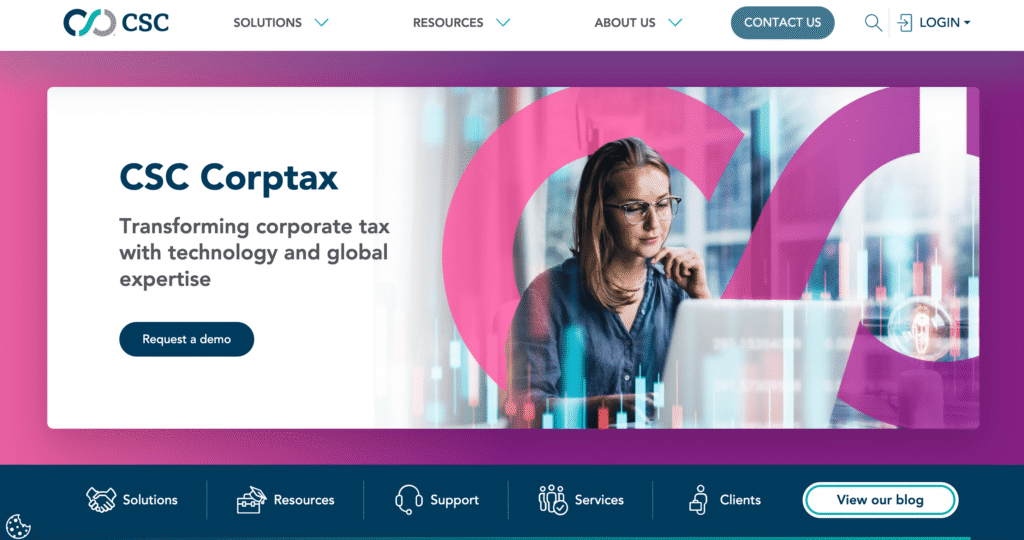
CSC Corptax has earned a distinguished reputation as a trusted provider of corporate tax technology for some of the most prominent global enterprises. Recognized for its ability to manage the entire corporate tax lifecycle with precision and transparency, it serves as the tax automation backbone for 50% of Fortune 500® companies and 60% of the Fortune 100.
Tax Transformation Suite – Comprehensive End-to-End Compliance
- Complete Lifecycle Coverage
- Streamlines every phase of the tax process, from provision and compliance to reporting, planning, and strategic analysis.
- Centralizes all tax data, enabling full visibility, instant access, and consistent governance across global operations.
- Automation and Efficiency Tools
- Corptax BOTS – Executes repetitive and time-intensive tasks automatically, reducing manual workload and human error.
- Corptax Data Exchange Manager – Enables hands-free data import and export between Corptax and key source systems, including general ledgers and entity structures.
- Enhances speed, accuracy, and process consistency across enterprise-scale tax operations.
Integration and Data Governance Excellence
- Seamless System Interoperability
- Designed to work effortlessly with core enterprise finance and ERP systems.
- Automates the movement of financial data between platforms, reducing duplication and ensuring data integrity.
- Data Governance Leadership
- Ensures a single source of truth for all tax-related information.
- Maintains compliance with stringent corporate governance standards and audit requirements.
Pricing Insights and ROI Potential
- Custom Quote Model
- Pricing tailored to enterprise size, industry complexity, and deployment requirements.
- Market Data Insights
- Average annual cost: USD 80,000
- Highest recorded cost: USD 130,500 based on third-party deal analysis
- Operational Value
- Delivers measurable ROI through reduced staffing hours, faster compliance cycles, and improved decision-making capacity.
Client Impact and Success Stories
- Role Transformation
- Automation through Corptax BOTS and Data Exchange Manager enables tax professionals to shift from compliance-focused roles to strategic tax operations management.
- Standardization of Processes
- Large corporations report moving from fragmented, manual workflows to unified, automated processes that save time and ensure consistency.
- Efficiency Gains
- Significant time savings across compliance and reporting cycles.
- Increased operational agility to respond to evolving tax regulations.
Comparative Benefits Table
| Feature / Benefit | CSC Corptax | Traditional Tax Management Approach |
|---|---|---|
| Target Market | Large enterprises, Fortune 500 & Fortune 100 | General corporate and mid-market companies |
| Lifecycle Coverage | Full tax lifecycle – provision to planning | Limited to compliance and filing |
| Automation Tools | Corptax BOTS, Data Exchange Manager | Manual processes |
| Integration Capabilities | ERP, general ledger, and financial system integration | Minimal or no automation |
| Data Governance | Full transparency and audit-ready governance framework | Fragmented records |
| Pricing Model | Custom enterprise quotes | Standard license/subscription |
| Operational Transformation | Shifts role focus to strategic tax operations | Primarily compliance-driven |
Why CSC Corptax is a Top Corporate Tax Software in 2025
- Unmatched Enterprise Adoption – Used by a majority of Fortune 500 and Fortune 100 companies, proving its large-scale reliability.
- Comprehensive Automation – Eliminates manual effort, enabling tax teams to focus on higher-value strategic functions.
- Scalable and Customizable – Designed for large, complex organizations that require tailored tax solutions.
- Data Integrity and Governance – Guarantees transparency, compliance, and operational control across global operations.
6. Sovos

Sovos stands out as a premier provider of enterprise tax compliance technology, offering a Compliance Cloud Platform engineered to meet the intricate demands of businesses operating in both domestic and global markets. By delivering a fully integrated, cloud-based suite, Sovos enables organizations to centralize tax operations, streamline compliance workflows, and ensure regulatory accuracy across multiple jurisdictions.
End-to-End Tax Management Capabilities
- Global Tax Determination Engine
- Always-on, real-time tax calculation for sales and use tax, VAT, and GST.
- Covers over 185 countries, providing unrivalled international reach for cross-border commerce.
- Dynamically adapts to changing regulations, ensuring ongoing compliance without manual intervention.
- Comprehensive Sales Tax Management
- Exemption Certificate Management – Digitally stores, validates, and monitors certificates to reduce audit risks.
- Automated Filing – Streamlines submission of tax returns to various jurisdictions with minimal human oversight.
- Deep Integrations – Seamlessly connects with ERP, e-commerce, and POS systems, reducing manual data transfers and errors.
Specialized Information Reporting Solutions
- 1099 Compliance Tools
- Offers tiered pricing based on filing volume, making it scalable for small businesses through to global enterprises.
- Designed for diverse corporate needs:
- Small businesses (under 100 forms): USD 2.99 per form.
- Mid-sized corporations (100–5,000 forms): Starting at USD 479 for the 1099 Professional product.
- Large enterprises: Custom enterprise-level pricing to meet complex, high-volume requirements.
Pricing Insights and Market Data
- Transparent and Tiered Model
- Accessible pricing for smaller organizations while offering scalability for multinational corporations.
- Third-Party Market Data
- Median spend: USD 16,006 per year.
- Range: USD 5,879 to USD 37,880 based on seven analyzed purchases.
- Value Proposition
- Balances cost-effectiveness with enterprise-grade capabilities, making it attractive for organizations with diverse tax compliance needs.
Customer Experience and Performance
- Strengths
- Recognized for being a single-source compliance solution, reducing the complexity of managing multiple systems.
- User-friendly interface, enabling quicker adoption by tax teams with varying technical proficiency.
- Areas for Improvement
- Feedback indicates declining customer support quality, including occasional communication challenges with technical assistance teams.
Comparative Advantage Table
| Feature / Capability | Sovos Compliance Cloud | Standard Tax Software Approach |
|---|---|---|
| Geographic Coverage | 185+ countries | Primarily domestic |
| Tax Types Supported | Sales & use tax, VAT, GST, 1099 reporting | Often limited to single or regional tax |
| Automation Level | End-to-end, real-time compliance automation | Partial automation |
| Integration Capabilities | ERP, e-commerce, POS | Limited or manual integration |
| Pricing Model | Tiered & scalable | Fixed subscription |
| Client Type Range | SMBs to multinational corporations | Narrower target audience |
Why Sovos is Among the Top Corporate Tax Software in 2025
- Global Reach with Local Precision – Covers more tax jurisdictions than most competitors, making it ideal for companies with cross-border operations.
- Scalability for All Business Sizes – Flexible tiered pricing ensures both small startups and large enterprises can benefit.
- Automation That Minimizes Risk – Real-time updates to tax rules protect businesses from costly compliance errors.
- Single-Source Compliance Management – Consolidates all tax operations under one platform, improving efficiency and transparency.
7. SAP Tax Management Module
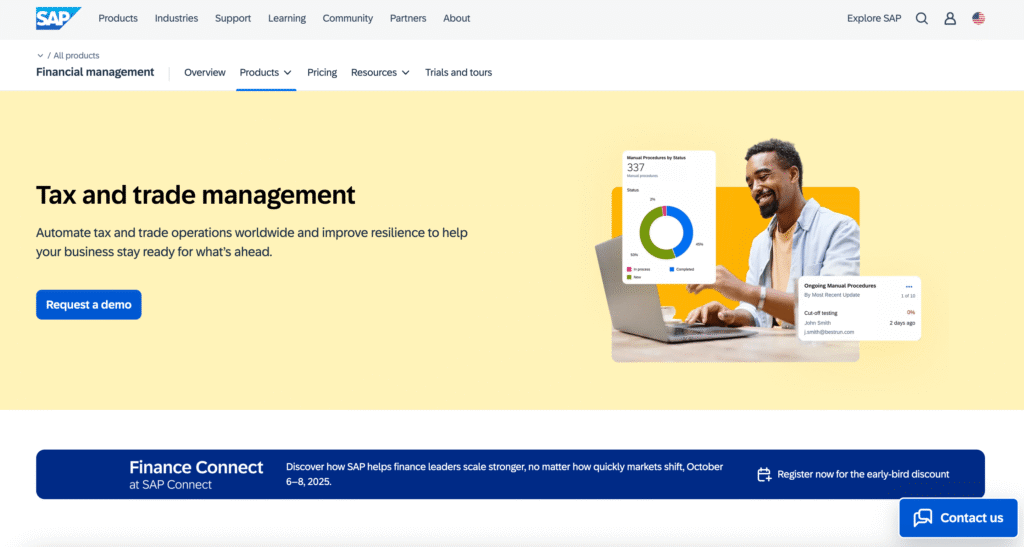
SAP’s Tax Management solutions are purpose-built for organizations operating within the SAP ecosystem, leveraging the platform’s ERP-native architecture to deliver a unified, enterprise-wide tax compliance framework. By embedding tax functionality directly into SAP’s core infrastructure, businesses benefit from a single source of truth for financial data, tax reporting, and trade compliance — eliminating the operational complexity often associated with third-party integrations.
Seamless Integration Across the Enterprise
- Native ERP Functionality
- Operates as an intrinsic part of SAP S/4HANA and other SAP ERP systems.
- Removes the need for external tax engines or custom-coded integrations.
- Unified Data Management
- Consolidates tax records, financial transactions, and compliance data within a centralized repository.
- Ensures consistent and accurate reporting across departments and regions.
Comprehensive Tax Compliance Capabilities
- SAP Tax Compliance for SAP S/4HANA
- Specializes in VAT management, customs duties, and jurisdiction-specific indirect taxes.
- Automates compliance checks, anomaly detection, and corrective workflows.
- SAP Responsible Design and Production
- Calculates environmental taxes and supports corporate sustainability commitments.
- Provides analytics for assessing environmental impact costs and compliance readiness.
- E-Invoicing & Digital Reporting
- Adheres to global e-invoicing mandates and digital tax filing requirements.
- Delivers real-time compliance monitoring from a centralized dashboard.
Pricing Model and Implementation Structure
- Custom Enterprise Licensing
- Pricing is tailored to each organization and typically bundled within a broader SAP enterprise agreement.
- Costs are influenced by company size, regional tax jurisdictions, and module configuration.
- Cost Efficiency Through Consolidation
- Eliminates the expense of third-party tax tools, reducing both integration costs and system maintenance overhead.
Business Impact and ROI
- Operational Efficiency
- Minimizes manual interventions by automating key compliance workflows.
- Digital Transformation Enabler
- Supports enterprise-wide initiatives to modernize finance and compliance infrastructure.
- Supply Chain and Inventory Optimization
- Integrates tax implications into procurement and logistics decisions, reducing delays and penalties.
Comparative Advantage Matrix
| Feature / Capability | SAP Tax Management Module | Third-Party Tax Engines |
|---|---|---|
| Integration Method | Native to SAP ERP | Requires external integration |
| Data Consistency | Single source of truth | Potential data duplication issues |
| Tax Scope | VAT, customs, environmental taxes | Varies by provider |
| Reporting | Real-time, centralized dashboard | May require separate reporting tools |
| Customization Needs | Minimal (pre-configured for SAP) | Often requires custom development |
| Compliance Automation | Fully embedded into ERP workflows | Dependent on integration quality |
Why SAP Tax Management Module is a Top Choice in 2025
- Perfect Fit for SAP-Integrated Enterprises – Optimized for organizations already running SAP ERP, reducing complexity and risk.
- Holistic Compliance Framework – Manages VAT, customs, environmental taxes, and e-invoicing from one platform.
- Future-Ready Tax Strategy – Adapts quickly to evolving global mandates through SAP’s continuous product updates.
- Proven in Large-Scale Transformations – Backed by case studies demonstrating operational cost reductions and compliance accuracy improvements in multinational corporations.
8. Oracle Tax Reporting Cloud
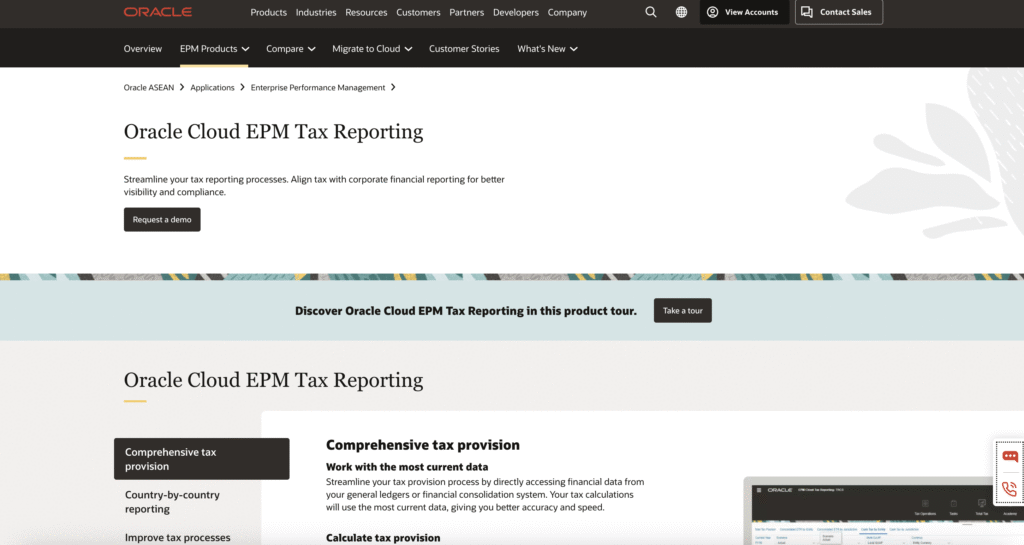
Oracle delivers its tax compliance and reporting capabilities through the Tax Reporting Cloud Service (TRCS), a fully integrated component of the Oracle Enterprise Performance Management (EPM) Cloud Suite. This solution is engineered to align corporate tax reporting directly with financial performance reporting, ensuring accuracy, transparency, and strategic insight across multinational operations.
Unified Tax and Financial Reporting
- Global Standard Compliance
- Supports both U.S. GAAP and IFRS frameworks, making it suitable for enterprises with cross-border operations.
- Facilitates Country-by-Country Reporting (CbCR) in compliance with OECD standards.
- Integrated Data Ecosystem
- Seamlessly connects with both Oracle and non-Oracle financial systems.
- Reduces manual reconciliation, creating more time for high-value analysis and strategic planning.
Advanced Functional Capabilities
- Tax Automation
- Automates tax provisioning processes, reducing operational risk and human error.
- Return-to-Accrual Automation
- Streamlines adjustments between tax return data and financial accruals, improving speed and accuracy.
- Centralized Data Collection
- Offers a unified platform for gathering and validating tax data across global subsidiaries.
Business Impact and ROI
- Operational Efficiency Gains
- Enables faster budget preparation cycles — in one documented case, a multinational communications company cut its budgeting timeline in half.
- Accuracy and Compliance Improvements
- Reduces discrepancies between tax and finance teams by creating a single version of the truth.
- Demonstrable ROI
- Case studies highlight enterprises achieving 100% ROI in the first year, primarily through process standardization and automation.
Comparative Feature Table
| Feature / Functionality | Oracle TRCS | Traditional Tax Provisioning Tools |
|---|---|---|
| Accounting Standards Support | U.S. GAAP & IFRS | Often limited to one standard |
| Country-by-Country Reporting | Built-in OECD-compliant CbCR | May require third-party add-ons |
| System Integration | Oracle & Non-Oracle Systems | Limited interoperability |
| Automation Level | Full tax lifecycle automation | Partial or manual workflows |
| ROI Potential | 100% in Year One (documented cases) | Variable |
Why Oracle Tax Reporting Cloud is a Top Choice in 2025
- Perfect Fit for Multinational Enterprises – Designed to meet the complexity of global tax compliance with integrated reporting tools.
- Cross-Platform Integration – Works seamlessly across Oracle and external financial systems, reducing silos and inefficiencies.
- Future-Proofed Compliance – Supports evolving tax standards and mandates, including BEPS and CbCR.
- Proven Business Outcomes – Backed by client success stories demonstrating measurable cost savings and strategic benefits.
9. Intuit Lacerte Tax
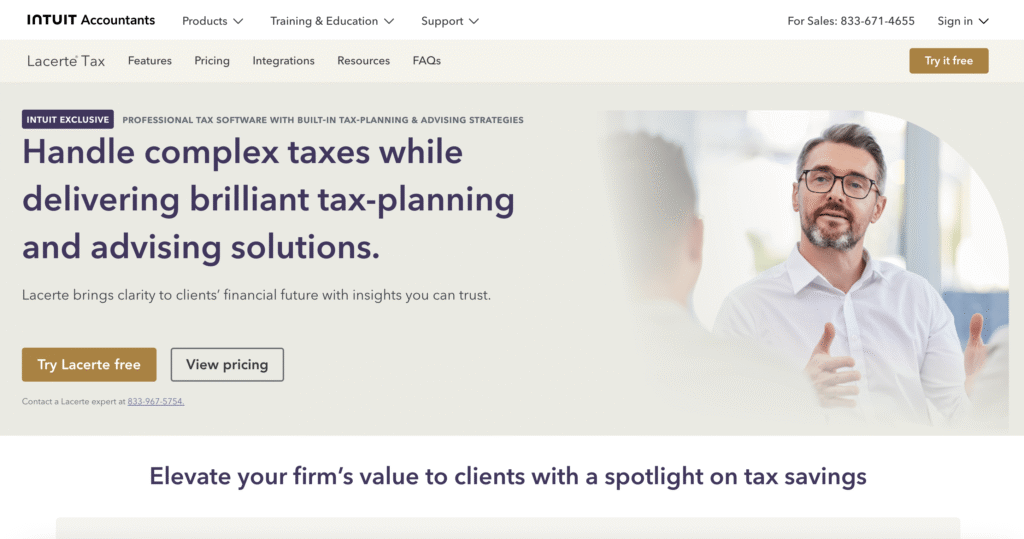
Intuit Lacerte Tax is a professional-grade desktop tax preparation platform purpose-built for Certified Public Accountants (CPAs) and high-volume accounting firms managing large volumes of complex tax returns. With a reputation spanning decades, Lacerte has become synonymous with accuracy, breadth of coverage, and reliability in the professional tax preparation market. In a 2024 CPA industry survey, it secured the position of second most widely used tax preparation software, reflecting its deep penetration in the accounting profession.
Specialized Strength in Complex Tax Scenarios
- Extensive Form Library
- Access to an unmatched collection of over 5,700 tax forms, covering federal, state, and local jurisdictions.
- Supports niche and high-complexity filings, including:
- Oil and Gas Taxation – managing deductions, depletion allowances, and production reporting.
- Consolidated Corporate Returns – simplifying inter-company eliminations and group filings.
- Form 5500 – ensuring compliance for employee benefit plans.
- Advanced Diagnostics Engine
- Real-time error detection with targeted guidance to minimize filing inaccuracies.
- Proactive compliance checks to align returns with evolving tax laws.
Pricing Models and Flexibility
- Pay-Per-Return Model
- Federal and one state return: USD 132 per filing.
- Additional state returns: USD 86 each.
- Separate charges for extensions to allow cost control for occasional needs.
- Unlimited Returns Package
- Annual fee of USD 636 for unlimited filings, ideal for high-volume practices.
Feature Comparison Matrix
| Feature / Functionality | Intuit Lacerte Tax | Typical Mid-Market Tax Software |
|---|---|---|
| Total Tax Forms Available | 5,700+ | 1,500–2,000 |
| Complex Return Handling | Yes (Oil & Gas, Consolidated, 5500) | Limited or requires add-ons |
| Diagnostic Checks | Advanced, real-time | Basic or periodic |
| Pricing Flexibility | Pay-per-return & unlimited packages | Mostly subscription-based |
| Professional-Grade Accuracy | High | Variable |
Why Intuit Lacerte Tax is Among the Top 10 in 2025
- Tailored for Tax Experts – Designed for firms that require granular control and a comprehensive feature set for specialized filings.
- Breadth of Coverage – One of the largest form libraries in the industry, ensuring no filing requirement is overlooked.
- Operational Efficiency – Streamlines preparation workflows for both routine and highly complex returns.
- Trusted Industry Reputation – Backed by decades of adoption among the most demanding CPAs and accounting firms.
10. Intuit ProConnect Tax

Intuit ProConnect Tax is a cloud-based professional tax preparation platform strategically designed for small to mid-sized accounting firms and independent tax practitioners seeking mobility, scalability, and streamlined workflows without the heavy infrastructure demands of traditional desktop software. Positioned as Intuit’s flagship online tax solution, ProConnect caters to professionals who value remote accessibility, simplified collaboration, and seamless integration with existing financial ecosystems.
Key Differentiators and Functional Capabilities
- Cloud-Native Accessibility
- Operates entirely online, eliminating the need for local installation, software updates, and IT maintenance.
- Enables multi-user, real-time collaboration across teams, offices, and client locations.
- Secure, role-based access for controlled data management.
- Native QuickBooks Online Integration
- Direct, automated data import from QuickBooks Online, reducing manual entry errors and saving substantial preparation time.
- Enhanced data synchronization for faster reconciliation and filing.
- Flexible Deployment and Scalability
- Designed for solo practitioners, boutique firms, and growing mid-tier practices.
- Supports both individual and business returns, adapting to diverse client portfolios.
Pricing Structure
- Pay-Per-Return Model – Cost-efficient for firms with seasonal or limited filing volumes.
- Bundled Packages – For higher-volume preparers, packages provide bulk filing allocations at reduced per-return costs.
- Example: ProConnect 1040 Essentials Package
- Includes 100 individual returns.
- Starting at USD 3,463 per year.
- Example: ProConnect 1040 Essentials Package
- Business Return Pricing – Available upon request, enabling customization based on volume and complexity.
- Trial Options – Offers a free trial with up to 14 days of access for certain services.
Feature Comparison Matrix
| Feature / Functionality | Intuit ProConnect Tax | Intuit Lacerte Tax |
|---|---|---|
| Deployment | Cloud-based | Desktop-based |
| Target User Base | Small to mid-sized firms, solo CPAs | High-volume, large-scale firms |
| QuickBooks Online Integration | Native | Partial via import tools |
| Form Library | Moderate (Individual & Business) | Extensive (5,700+ forms) |
| IT Maintenance Required | None | Required (desktop environment) |
| Collaboration | Real-time multi-user | Local network-based |
| Pricing Model | Pay-per-return or bundle | Pay-per-return or unlimited package |
Strengths Driving its Ranking in the Top 10 for 2025
- Unmatched Mobility in its Category – Empowering tax professionals to work from any device, anywhere, with immediate access to client files.
- Operational Efficiency – Direct QuickBooks Online integration accelerates data preparation and reconciliation.
- Cost-Effective Scalability – Pay-per-return pricing offers flexibility for firms with varying seasonal workloads.
- Collaborative Advantage – Real-time co-working on returns eliminates version control issues and improves turnaround times.
Considerations for Adoption
- User Experience Variability – While many users praise its ease of use and time-saving automation, others cite system inconsistencies and long customer support response times.
- Best Fit – Firms prioritizing speed, mobility, and QuickBooks Online integration over the depth of advanced complex return handling will find ProConnect especially beneficial.
The 2025 Corporate Tax Software Landscape: A Comprehensive Expert Report – Market Dynamics, Trends, and Growth Catalysts
Global Market Overview
- The corporate tax software sector enters 2025 in a phase of accelerated transformation, underpinned by a convergence of regulatory, technological, and economic forces.
- Valued at USD 22.78 billion in 2024, the market is forecast to scale to USD 59.85 billion by 2034, reflecting a compound annual growth rate (CAGR) of 10.14%.
- This growth trajectory positions tax management platforms as a core component of corporate finance infrastructure, no longer a peripheral tool.
Regional Performance Highlights
- North America:
- Holds a 29% market share in 2024, equating to USD 6.61 billion in value.
- Projected to expand to USD 12.45 billion by 2034 at a CAGR of 10.42%.
- Dominance driven by:
- High digital adoption rates.
- Complex multi-jurisdictional compliance requirements.
- Strong demand for cloud-based and AI-enhanced tax automation.
- Asia Pacific:
- Expected to record the fastest growth rate globally.
- Rising adoption in emerging economies due to governmental e-filing mandates and corporate digitalisation programs.
Growth Drivers
- Regulatory Complexity:
- Intensification of global and local compliance requirements.
- Increased volume and granularity of real-time transaction reporting obligations.
- Digital Transformation in Finance:
- Enterprises seek to integrate tax management into broader ERP and financial analytics ecosystems.
- Rising adoption of AI, machine learning, and blockchain in tax reporting and compliance tracking.
- Scalability Demand:
- Tax solutions now catering to SMEs, enabling automation and accuracy without enterprise-scale infrastructure.
Market Segmentation Insights
- By Enterprise Size:
- Large Enterprises: Maintain the dominant market position due to higher budgets and compliance needs.
- Small & Medium Enterprises (SMEs): Anticipated to be the fastest-growing segment due to cloud-based subscription models and user-friendly solutions.
- By Industry Vertical:
- BFSI Sector:
- Historically slower to adopt, now leading in adoption rates.
- Driven by the need for precise, real-time, multi-jurisdictional compliance capabilities.
- Retail & E-commerce:
- Rapid uptake to manage digital sales taxes and cross-border VAT/GST obligations.
- BFSI Sector:
Comparative Market Growth Table (2024–2034 Forecast)
| Region | 2024 Market Size (USD Bn) | 2034 Projected Size (USD Bn) | CAGR (%) |
|---|---|---|---|
| North America | 6.61 | 12.45 | 10.42 |
| Asia Pacific | 4.05 | 11.20 | 10.85 |
| Europe | 5.78 | 13.40 | 9.05 |
| Latin America | 2.15 | 5.05 | 8.95 |
| Middle East & Africa | 1.19 | 3.75 | 11.25 |
Expert Perspective
- Analysts observe that tax technology is evolving from a compliance necessity into a strategic enabler of operational agility and data-driven decision-making.
- By 2025, competitive advantage in the corporate tax software market will depend on:
- Interoperability with ERP/accounting ecosystems.
- Advanced analytics and forecasting capabilities.
- Adaptability to rapid legislative changes across multiple jurisdictions.
The 2025 Corporate Tax Software Landscape: Navigating Regulatory Change and Technological Transformation
Evolving Global Compliance Demands
- The corporate tax software market in 2025 is not solely a reflection of technological progress—it is intrinsically shaped by the accelerating pace of global tax reforms.
- Enterprises are under mounting pressure to navigate an ever-expanding portfolio of regulatory obligationsacross multiple jurisdictions.
- Legislative shifts—such as the OECD’s Base Erosion and Profit Shifting (BEPS) framework and the Global Minimum Tax—are redefining the parameters of compliance for multinational corporations.
Impact of Regulatory Reforms on Software Architecture
- Software solutions must be:
- Multi-jurisdictional – able to manage tax obligations across diverse geographies.
- Adaptable in real time – ensuring rapid compliance updates as legislation evolves.
- Configurable without heavy coding – empowering finance teams to tailor solutions without waiting for lengthy development cycles.
- Case in Point – Wolters Kluwer’s CCH Integrator:
- Incorporates a dedicated Pillar Two calculation engine.
- Uses a low-code framework for swift adaptation to evolving OECD guidelines and local tax laws.
- Digital Services Taxes (DSTs) and mandatory e-invoicing in regions such as LATAM require:
- Integrated multi-currency capabilities.
- Country-specific compliance templates.
- Scalable integration with enterprise resource planning (ERP) systems.
Economic Incentives for Digital Compliance
- Beyond legal compliance, digital adoption offers measurable financial advantages.
- Avalara’s study highlights:
- USD 616 billion in potential combined annual economic benefit across six major markets via e-invoicing adoption.
- For U.S. enterprises:
- USD 15.16 saved per invoice received.
- USD 1.1 million annual productivity gains per firm.
- Automation also cuts fraud and tax fines by approximately 30%, reinforcing the business case for immediate investment.
The Rise of Artificial Intelligence in Tax Operations
- AI is no longer experimental—it is a mainstream driver of transformation in corporate tax workflows.
- Notable AI Implementations:
- Thomson Reuters – Ready to Advise / Ready to Review:
- Built on an agentic AI platform with the CoCounsel assistant.
- Capable of automating high-volume tasks such as document processing, data extraction, and preliminary tax strategy identification.
- Estimated to save tax professionals 240 hours annually (approx. six work weeks).
- TaxGPT:
- Specialised AI model trained on U.S. tax law.
- Designed for advanced research and analysis rather than direct compliance execution.
- Thomson Reuters – Ready to Advise / Ready to Review:
AI Deployment Patterns and Limitations in 2025
- AI as a Force Multiplier, Not a Replacement:
- Current AI solutions excel in data-intensive, repetitive functions but stop short of full compliance automation.
- For example:
- TaxGPT delivers accurate research but requires human intervention for compliance application.
- Ready to Review outputs tax returns “ready for human review” rather than bypassing professional oversight.
- Critical Takeaway:
- AI in 2025 functions as a strategic augmentation tool.
- Complex decision-making, high-stakes analysis, and final review remain firmly human-driven.
Comparative Snapshot – AI in Corporate Tax Software (2025)
| Feature | TaxGPT | Ready to Advise / Review | Legacy Compliance Tools |
|---|---|---|---|
| Core Function | Research engine | Workflow automation + review | Manual data entry + review |
| AI Integration Level | High (analysis-focused) | High (process automation) | Low |
| Compliance Workflow Capability | None – requires human action | Partial – human review needed | Full manual oversight |
| Time Savings | High (research efficiency) | Very High (processing + review) | Low |
| Target User | Tax researchers, advisors | Tax preparers, compliance teams | Compliance clerks, accountants |
Strategic Outlook for 2025
- Enterprises adopting corporate tax software must assess:
- Adaptability to shifting regulations.
- Integration with AI for efficiency without sacrificing oversight.
- Scalability to handle growth in transaction volume and jurisdictional complexity.
- The most competitive vendors will be those that blend regulatory intelligence, automation capabilities, and user-centric design into cohesive, future-proof platforms.
Comparative Analysis and Strategic Recommendations
The 2025 Corporate Tax Software Landscape: Expert Review & Insights
Comprehensive Comparative Overview of Leading Platforms
To navigate the increasingly complex tax compliance environment, decision-makers require not just a list of popular platforms but a structured, data-driven comparison. The following matrix consolidates essential factors—target audience, pricing, feature set, global reach, and integration capabilities—allowing enterprises to match solutions with their operational scope, compliance challenges, and digital transformation maturity.
Table – Comparative Overview of Prominent Corporate Tax Software Solutions in 2025
| Vendor | Primary Platform(s) | Target Audience | Pricing Model | Core Features | Global Reach | Key Integrations |
|---|---|---|---|---|---|---|
| Thomson Reuters | ONESOURCE & UltraTax CS | Multinationals & Professional Firms | Custom Quote, Per-Return, Subscription | Direct Tax, Indirect Tax, Global Trade, Provision, AI Agents | US & Global | SAP, Onvio, TaxCaddy, TaxScan |
| Avalara | AvaTax | E-commerce, Mid-Market & Enterprise | Subscription, Per-Filing | Sales & Use Tax, VAT/GST, E-invoicing, Certificate Management | US & Global | 1,400+ ERP, E-commerce, Financial Systems |
| Vertex | O Series & VAT Compliance | Large Enterprises & Fortune 500 | Custom Quote | Indirect Tax, VAT/GST, E-invoicing, Certificate Management | 130+ Countries | SAP, Oracle, NetSuite, Salesforce |
| Wolters Kluwer | CCH Axcess Tax & CCH Integrator | Professional Firms & Multinationals | Custom Quote, Per-Module | Firm Management, Direct Tax, CbCR, Pillar Two, 6,000+ Forms | US & Global | Microsoft Excel, QuickBooks, SAP, NetSuite |
| CSC Corptax | Tax Transformation Suite | Large Enterprises & Fortune 500 | Custom Quote | Full Tax Lifecycle, Bots, Data Exchange, Provision | 100 Countries | BI Applications, Third-Party Tools, Databases |
| Sovos | Compliance Cloud | All Business Sizes | Per-Form, Per-Filing, Custom Quote | Global Tax Determination, VAT/GST, 1099/1095 Reporting | 185+ Countries | ERP, E-commerce Systems |
| SAP | Tax Management Module | SAP Ecosystem | Custom Quote (ERP-tied) | VAT, E-invoicing, Customs Duties, Reporting | Global | Native SAP ERP Integration |
| Oracle | Tax Reporting Cloud | Multinationals | Custom Quote (EPM-tied) | Provision, CbCR, GAAP/IFRS Reporting | Global | Oracle, Hyperion, Non-Oracle Finance Systems |
| Intuit Lacerte | Lacerte Tax | High-Volume Professional Firms | Per-Return, Subscription | US Federal & State Forms, 5,700+ Tax Forms | US-Centric | Intuit Link, Quick Cloud Hosting |
| Intuit ProConnect | ProConnect Tax | Small Professional Firms | Per-Return, Subscription | US Federal & State Forms | US-Centric | QuickBooks Online, Xero, Microsoft Excel |
| Longview | Longview Tax | Large Organizations | Custom Quote | Planning, Provisioning, Reporting, Analytics | Global | Infor, Oracle, Sage, Deltek, HFM, JD Edwards |
Strategic Insights for Platform Selection in 2025
Choosing the right corporate tax software in 2025 is no longer a matter of ticking off feature lists—it is a strategic alignment exercise between business objectives, regulatory demands, technological ecosystems, and financial constraints.
Key Selection Considerations
• Cost vs. Complexity vs. Capability
- Enterprise-grade solutions (e.g., Thomson Reuters, Vertex, CSC Corptax) provide comprehensive coverage for global operations but require significant investment in licensing, implementation, and training.
- Smaller-scale, US-centric tools (e.g., Intuit Lacerte, ProConnect) are cost-effective for limited jurisdictions but can lead to compliance gaps if a business expands internationally.
- Underestimating future requirements risks expensive migrations, while over-investing in unnecessary capabilities leads to underutilized systems and prolonged ROI cycles.
• Ecosystem vs. Best-of-Breed Approach
- Ecosystem Strategy: Adopting a vendor’s entire suite ensures streamlined workflows, uniform user experience, and single-vendor accountability (e.g., Wolters Kluwer for tax, firm management, and compliance).
- Best-of-Breed Strategy: Selecting specialized platforms for specific needs (e.g., Avalara for sales tax automation) delivers depth in functionality but introduces integration complexity and potential data silos.
- The decision hinges on operational priorities: simplicity and centralization versus specialized capability with higher IT orchestration demands.
• Global Reach and Localization
- Companies operating across multiple tax jurisdictions must prioritize platforms with robust multi-jurisdictional support, real-time tax rate updates, and localized compliance modules.
- LATAM, EU, and APAC tax ecosystems have unique e-invoicing, VAT, and GST structures, making localized expertise a decisive factor.
• Integration and Workflow Automation
- Seamless ERP, CRM, and e-commerce integrations minimize manual data entry, reduce reconciliation errors, and accelerate compliance cycles.
- The number and quality of pre-built integrations directly impact implementation timelines and total cost of ownership.
• Support, Training, and User Experience
- High-functionality platforms often suffer from inadequate customer support, leading to operational inefficiencies.
- User adoption depends on intuitive interface design, accessible training resources, and responsive vendor assistance.
- Strong post-deployment support is essential to maintain compliance continuity and ensure sustained ROI.
Market Positioning Matrix: Cost vs. Capability
| Capability Level | Low Cost | Medium Cost | High Cost |
|---|---|---|---|
| High Capability | – | Avalara, Wolters Kluwer | Thomson Reuters, Vertex, CSC Corptax |
| Medium Capability | Intuit ProConnect | SAP, Sovos | Oracle, Longview |
| Low Capability | – | – | – |
Final Strategic Recommendation
A methodical selection process for corporate tax software in 2025 must go beyond vendor marketing promises.
- Conduct a needs assessment aligned with both current compliance requirements and projected expansion plans.
- Evaluate total cost of ownership by factoring in licensing, implementation, training, integration, and ongoing support.
- Test user experience through trial deployments, ensuring tax teams can navigate workflows efficiently.
- Incorporate vendor reliability metrics such as support response times, training availability, and historical uptime rates.
- Consider future-proofing—select platforms that demonstrate agility in adapting to emerging tax reforms, AI-driven automation, and global compliance mandates.
Future Outlook for Corporate Tax Technology: The 2025 and Beyond Landscape
Key Emerging Dynamics in the Corporate Tax Software Market
• Global Regulatory Acceleration
– The tax compliance environment is experiencing unparalleled transformation, driven by continuous international reforms and jurisdiction-specific mandates.
– Regulatory bodies are enforcing more intricate frameworks such as the OECD’s Pillar Two, digital services taxation, and mandatory e-invoicing, pushing vendors to develop flexible, multi-jurisdictional, and real-time adaptable platforms.
– The compliance function is evolving from a reactive, cost-incurring obligation to a proactive, data-driven strategic asset.
• Cloud-Integrated and AI-Embedded Platforms
– Corporate tax technology is transitioning from siloed applications to cloud-first, AI-powered ecosystems that integrate seamlessly with ERP and business intelligence tools.
– The shift towards “agentic AI” — AI acting as an embedded, task-specific operational partner — is reducing manual intervention while enabling predictive analytics and strategic scenario planning.
– AI deployment in tax processes is moving from research-only capabilities toward execution-ready outputs, ensuring faster turnaround, reduced operational risk, and enhanced accuracy.
• Tangible, Quantifiable Value of Automation
– Automation is now a measurable driver of financial performance, delivering significant ROI, time efficiency, and error reduction.
– Businesses are achieving substantial productivity gains — in some cases, freeing up thousands of professional hours annually — enabling tax teams to focus on high-value advisory and forecasting functions.
– The market data suggests that organizations leveraging end-to-end, cloud-based platforms experience improved compliance, reduced audit risk, and enhanced financial visibility.
Strategic Implications for 2025 and Beyond
• AI as an Operational Co-Pilot
– Vendors like Thomson Reuters are leading the movement toward embedded AI that acts as an intelligent co-pilot in daily workflows, automating complex compliance tasks while maintaining human oversight for high-stakes decision-making.
• Consolidation of Major Players
– The competitive landscape is gradually centralizing around a small group of technology leaders capable of delivering multi-jurisdictional compliance and end-to-end automation across direct and indirect tax functions.
• Transformation of the Tax Function
– The most competitive enterprises in 2025 will not simply aim for compliance efficiency but will use their tax software as a strategic intelligence hub — leveraging predictive analytics, scenario modeling, and real-time compliance monitoring to guide broader corporate strategy.
Table: Quantitative Efficiency and ROI Metrics in Corporate Tax Technology
| Vendor | Metric Description | Value | Source/Context |
|---|---|---|---|
| Avalara | 3-Year ROI for composite organization | 153% | Forrester Total Economic Impact study |
| Avalara | 3-Year NPV for composite organization | $465,000 | Forrester Total Economic Impact study |
| Avalara | Reduction in time on tax returns | 85% | Forrester study |
| Avalara | Time saved in exemption certificate management | 50% | Forrester study |
| Avalara | Efficiency gain in audit preparation | 85% | Forrester study |
| Avalara | Annual U.S. business gains from e-invoicing | $116 billion | Avalara and Cebr global research |
| Longview | Manual tax process time reduction | From 1 week to 1 day | Customer case study with BiC (80% time saving) |
| Thomson Reuters | Annual duties saved by ONESOURCE users | $1 billion+ | Internal ONESOURCE analysis |
| Thomson Reuters | Time saved in indirect tax compliance | 50% | Forrester study |
| Thomson Reuters | Efficiency gains in statutory reporting | 68% | Forrester study |
| Thomson Reuters | Processing time reduction for high-volume returns | 50% | Internal ONESOURCE report |
| Thomson Reuters | Annual hours saved using AI | 240 hours | Thomson Reuters 2025 Future of Professionals Report |
| Wolters Kluwer | Reduction in manual data collation and review time | 50% | Customer case study in life sciences sector |
| Vertex | Staff reduction for certificate entry | From 200 to 25 | Customer case study with Graybar |
| Oracle | Budget preparation time reduction for MTN Group | 50% | Customer case study |
| Oracle | ROI for standardized tax solution | 100% in Year 1 | Customer case study with consulting firm |
Growth Outlook Chart: AI and Automation Adoption in Corporate Tax Software (2023–2027 Projection)
• 2023 – 35% adoption of AI-driven tax platforms
• 2024 – 48% adoption
• 2025 – 65% adoption
• 2026 – 78% adoption
• 2027 – 85% adoption
Competitive Advantage Forecast
• Enterprises that adopt AI-integrated, cloud-based tax platforms by 2025 are projected to:
– Reduce compliance-related costs by up to 40%
– Shorten tax cycle timelines by up to 60%
– Achieve ROI payback within 12–18 months of implementation
– Reduce audit-related penalties by up to 30%
Conclusion
In conclusion, selecting the right corporate tax software in 2025 is no longer just a matter of convenience—it is a strategic necessity for businesses aiming to maintain compliance, improve accuracy, and streamline their tax management processes in an increasingly complex financial environment. With the evolving landscape of tax regulations, the rise of digital transformation in finance, and the growing demand for data security, the right software can significantly reduce risks, save time, and enhance operational efficiency.
The top 10 corporate tax software solutions featured in this guide have been carefully identified based on their capabilities, technological innovation, and ability to address the challenges faced by modern enterprises. From advanced automation tools that minimise manual errors to AI-powered analytics that provide real-time insights, each platform offers distinct advantages designed to meet the needs of different business sizes and industries. Whether a company operates domestically or across multiple jurisdictions, there is now software capable of handling complex compliance requirements, managing multi-currency reporting, and integrating seamlessly with existing accounting or ERP systems.
For small and medium-sized enterprises, these solutions can help reduce the administrative burden of tax filing, ensuring that deadlines are met and deductions are optimised without requiring excessive manpower. For large corporations, many of the highlighted platforms deliver robust scalability, advanced reporting features, and enhanced data governance, enabling tax teams to work more strategically rather than spending hours on repetitive tasks. The increasing use of cloud-based corporate tax software also means that businesses can now manage their tax operations securely from anywhere, with automatic updates ensuring they are always compliant with the latest regulations.
Another significant factor driving the adoption of these tools is the integration of AI, machine learning, and predictive analytics into tax compliance systems. These technologies are not just automating tasks; they are providing deep insights into potential risks, identifying opportunities for tax optimisation, and enhancing decision-making at both operational and strategic levels. In 2025, companies that leverage such intelligent solutions will be better positioned to adapt to changes in taxation laws and economic conditions.
Ultimately, the choice of corporate tax software should align with a business’s specific operational requirements, industry regulations, and growth plans. A thorough evaluation of features, pricing models, customer support, and scalability is essential before committing to any platform. As the pace of digital transformation in finance accelerates, investing in a robust and future-ready tax management solution is not merely about keeping up—it’s about gaining a competitive edge in compliance, efficiency, and cost management.
Businesses that adopt the right corporate tax software now will not only benefit from immediate operational improvements but will also position themselves for long-term success in a regulatory environment that is only becoming more demanding. The tools outlined in this list offer the innovation, reliability, and adaptability that forward-thinking organisations need to thrive in 2025 and beyond.
If you find this article useful, why not share it with your hiring manager and C-level suite friends and also leave a nice comment below?
We, at the 9cv9 Research Team, strive to bring the latest and most meaningful data, guides, and statistics to your doorstep.
To get access to top-quality guides, click over to 9cv9 Blog.
To hire top talents using our modern AI-powered recruitment agency, find out more at 9cv9 Modern AI-Powered Recruitment Agency.
People Also Ask
What is corporate tax software and why is it important for businesses?
Corporate tax software automates tax calculations, ensures compliance with regulations, and reduces errors, making tax filing faster, more accurate, and more efficient for businesses.
How can corporate tax software improve accuracy in tax filing?
It reduces manual entry errors by automating calculations, applying the latest tax laws, and generating precise reports for accurate filings.
What are the key features to look for in corporate tax software in 2025?
Look for automation, cloud integration, multi-country compliance, real-time updates, analytics, and secure data management.
Why is cloud-based corporate tax software becoming popular in 2025?
Cloud-based solutions allow remote access, real-time collaboration, automatic updates, and better data security.
How does corporate tax software help with compliance in multiple countries?
It includes multi-jurisdictional tax rules, currency conversions, and region-specific compliance features.
What are the benefits of using AI-powered corporate tax software?
AI improves data analysis, detects anomalies, predicts tax liabilities, and automates repetitive tasks.
Can corporate tax software integrate with accounting tools?
Yes, most modern tax software integrates seamlessly with accounting and ERP systems for smoother workflows.
Is corporate tax software suitable for small businesses?
Yes, many providers offer scalable solutions with features tailored to small and medium-sized enterprises.
How does corporate tax software handle frequent tax law changes?
It updates automatically with the latest regulations to ensure compliance without manual adjustments.
Can corporate tax software save time during tax season?
Yes, automation and streamlined processes significantly reduce the time needed for tax preparation and filing.
Is corporate tax software secure for sensitive financial data?
Yes, reputable software includes encryption, secure servers, and multi-factor authentication to protect data.
How much does corporate tax software typically cost in 2025?
Pricing varies based on features, scalability, and user licenses, ranging from monthly subscriptions to enterprise plans.
Can corporate tax software generate audit-ready reports?
Yes, most solutions provide detailed, compliant reports to prepare for audits efficiently.
Does corporate tax software support e-filing?
Yes, leading tax software offers direct e-filing capabilities with tax authorities for faster submissions.
What industries benefit most from corporate tax software?
Industries with complex tax requirements, such as finance, manufacturing, and global corporations, benefit most.
Can corporate tax software be customized for unique tax needs?
Yes, many solutions offer customizable workflows, templates, and modules for specific business needs.
How do businesses choose the best corporate tax software in 2025?
Evaluate based on features, ease of use, compliance capabilities, scalability, and customer support.
What is the role of automation in corporate tax software?
Automation speeds up data entry, calculations, and compliance checks, reducing manual workload.
Does corporate tax software offer real-time financial insights?
Yes, many provide dashboards with live tax liability updates and forecasting tools.
Can corporate tax software handle multiple entities under one account?
Yes, multi-entity management is a key feature in enterprise-grade tax software.
How do cloud backups enhance corporate tax software security?
They ensure data recovery in case of hardware failure, cyberattacks, or accidental deletions.
Can corporate tax software reduce operational costs?
Yes, it lowers manual labor, minimizes errors, and avoids costly compliance penalties.
What are the top trends in corporate tax software for 2025?
AI-driven analytics, blockchain integration, enhanced automation, and global tax compliance are trending.
Does corporate tax software require special training?
Some advanced features may need training, but many are designed for ease of use.
Can corporate tax software integrate with payroll systems?
Yes, integration with payroll ensures accurate withholding and compliance.
How does corporate tax software help during audits?
It organizes records, provides detailed transaction histories, and generates compliance-ready documentation.
Is mobile access available for corporate tax software in 2025?
Yes, many providers offer mobile apps or responsive web platforms for on-the-go access.
Can corporate tax software track tax deadlines automatically?
Yes, it includes reminders and alerts to prevent missed deadlines.
Does corporate tax software work for both domestic and international taxes?
Yes, advanced solutions support multi-country tax compliance and filings.
How does AI improve decision-making in corporate tax software?
AI analyzes large datasets to provide strategic tax-saving recommendations and risk alerts.
Sources
Precedence Research
Fortune Business Insights
Papaya Global
Global People Strategist
Wolters Kluwer
PR Newswire
Avalara
Thomson Reuters
Sphere
Ace Cloud Hosting
Accounting.com
AWS Marketplace
The CFO Club
TrustRadius
Zamp
Forrester
CSM Practice
TaxCloud
Vendr
Vertex Inc.
Fit Small Business
CSC Global
Sovos
SAP
Oracle
LeanIX
SAP Insider
MindStream Analytics
Bluebird Consulting
Innovate Tax
Himanshu Tyagi
Intuit Accountants
Gartner
Software Connect
Research.com
Insightsoftware












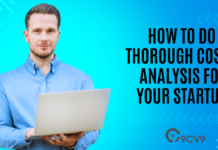












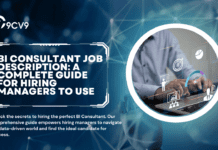


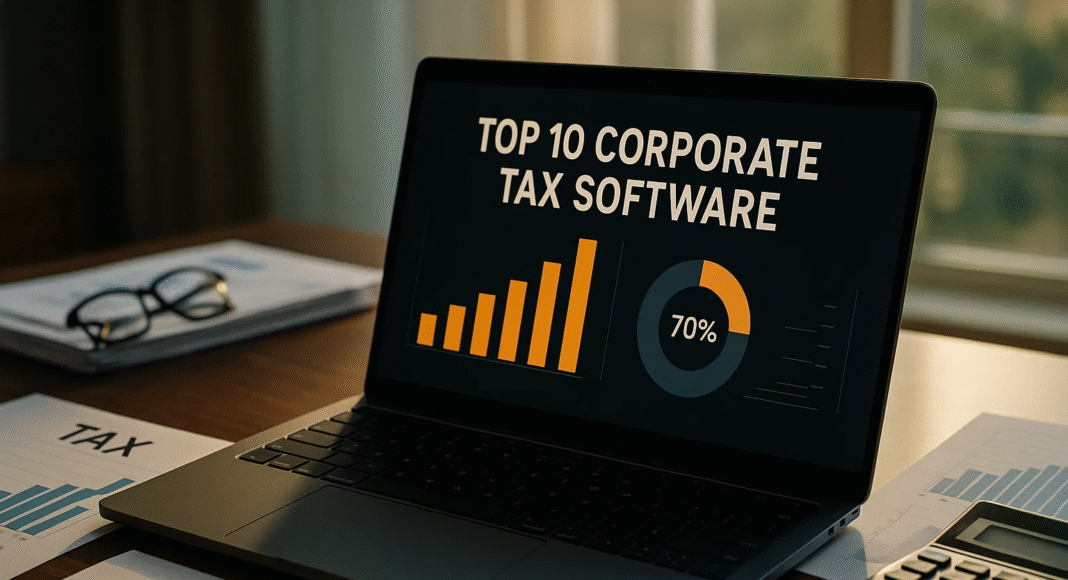


![Writing A Good CV [6 Tips To Improve Your CV] 6 Tips To Improve Your CV](https://blog.9cv9.com/wp-content/uploads/2020/06/2020-06-02-2-100x70.png)


